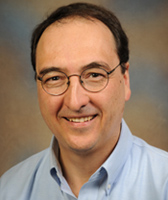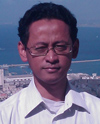Programming Biology: Q & A with Richard Murray
By Cynthia Weber
IEEE Life Sciences talks with Richard Murray, Professor of Control & Dynamical Systems and Bioengineering at Caltech, about the promise of synthetic biology; the goals of the SEED conference, an annual technical conference dedicated to the broad spectrum of technologies that fall under the umbrella of synthetic biology, which Murray helped found in 2014; and his own research in biomolecular feedback circuits.
IEEE LS: We seem to be hearing about “synthetic biology” more and more these days. Can you describe what is meant by this term?
RM: Synthetic biology is an engineering discipline focused on the design and construction of genetically-encoded devices, pathways, networks, and systems that allow us to harness some of the capabilities of biology. One way of thinking about synthetic biology is that engineers design circuits and pathways that can be programmed to operate using DNA. Some of these circuits are inserted into cells (such as yeast and non-pathogenic E. coli) in order to carry out a specific function, but others can operate in cell-free environments (pure buffer or cell lysates). The challenge in synthetic biology is learning how to systematically design and implement bimolecular circuits that carry out useful functions such as synthesis of materials (biofuels, specialty chemicals), detection of molecular events in their environment, and biologically-compatible computations.
IEEE LS: What research areas are often encompassed under this term?
RM: I believe that synthetic biology encompasses a spectrum of technologies, theory, and processes that have been developed in many other disciplines (biology, chemistry, chemical engineering, computer science, electrical engineering, for example), as well as new approaches that are unique to synthetic biology. Areas such as metabolic engineering, protein engineering, biomolecular design, molecular programming, and engineering of biology are all part of the large umbrella of areas that I would classify as “synthetic biology.”
IEEE LS: Can you tell us about your own work in this area?
RM: Most of my research group works on topics related to the implementation of biomolecular feedback circuits. The main idea we are pursuing is to understand how we can use engineered feedback systems to improve the performance, robustness, and modularity of engineering biological circuits. One example is a circuit that my students Victoria Hsiao and Emzo de los Santos worked on that allows you to regulate the concentration of one protein so that it tracks another protein’s concentration. This has potential applications in metabolic engineering, where you need to control the concentrations of different enzymes in a pathway. We also do a lot of work in creating protocols for implementing cell-free “prototyping,” similar to the type of work that electrical engineers do when they use electrical breadboards.
IEEE LS: What draws you to these types of research topics?
RM: When you look at what nature is capable of doing with biological components, it is clear that biology provides a powerful set of tools for creating materials, detecting events in the world around us, and creating complex machines that perform interesting functions (like reading the article -:). What is even more amazing is that biological systems work at the molecular scale: a micro-organism might only be 1-10 microns in length, and yet it can take in nutrients and convert them to the energy required to operate, move around in response to stimuli in its environment, and create complex materials (from DNA to beer). If we can harness even a fraction of the capabilities that nature has provided, I think we can do some pretty amazing things for society and for the planet.

Richard M. Murray received a B.S. degree in Electrical Engineering from California Institute of Technology in 1985 and M.S. and Ph.D. degrees in Electrical Engineering and Computer Sciences from the University of California, Berkeley, in 1988 and 1991, respectively. He is currently the Thomas E. and Doris Everhart Professor of Control & Dynamical Systems and Bioengineering at Caltech. Murray’s research is in the application of feedback and control to networked systems, with applications in biology and autonomy. Current projects include analysis and design of biomolecular feedback circuits; specification, design, and synthesis of networked control systems; and novel architectures for control using slow computing.
IEEE LS: How do you see the conference you cofounded, SEED, build on the promise of synthetic biology research?
RM: Our purpose in establishing the SEED conference was to create an annual conference in which the many different parts of the synthetic biology technical community could come together and share the latest advances in the field. The conference is a combination of invited talks, contributed talks, and posters, so that many different groups (PIs, new researchers, postdocs, graduate students, etc.) can talk about their work.
IEEE LS: How do you envision the role of the SEED conference in moving the field forward in the coming years?
RM: The conference is off to a great start and I hope that it will continue to draw a broad collection of people interested in synthetic biology, who will tell the community about their latest achievements and advances. Going forward, I would hope that SEED is viewed by synthetic biology researchers and practitioners as a key place to find more information on the latest results and technologies impacting the field, catch up with their colleagues from around the world, learn about new companies and products being launched, and meet students and postdocs who are driving innovative results in the field.
IEEE LS: Looking forward, what do you believe the future holds for synthetic biology?
RM: The field is very much in its infancy, with less than 50 years of history since some of the earliest days of the field, with a surge in interest over the last decade or two. At this point, I’m not sure yet whether synthetic biology will live up to the vision that many of us have for the field, but I hope that it will create new ways of synthesizing complex materials, interacting with biological systems, and understanding (and caring for) the world around us.
IEEE LS: It appears that we may have much more to learn from this field, and we look forward to hearing more from SEED 2016. Thank you for taking the time to talk with us.
Cynthia Weber is Associate Editor for the IEEE Life Sciences Newsletter.







 Richard M. Murray is currently the Thomas E. and Doris Everhart Professor of Control & Dynamical Systems and Bioengineering at Caltech. Murray's research is in the application of feedback and control to networked systems, with applications in biology and autonomy.
Richard M. Murray is currently the Thomas E. and Doris Everhart Professor of Control & Dynamical Systems and Bioengineering at Caltech. Murray's research is in the application of feedback and control to networked systems, with applications in biology and autonomy.  Steffen Waldherr is an assistant professor for theory of complex networks at the Otto-von-Guericke-University, Magdeburg, Germany. His research interests focus on systems engineering methods for biomolecular networks and cell-biological systems, including modeling, uncertainty and robustness analysis, optimization, non-linear dynamics, and cell populations models.
Steffen Waldherr is an assistant professor for theory of complex networks at the Otto-von-Guericke-University, Magdeburg, Germany. His research interests focus on systems engineering methods for biomolecular networks and cell-biological systems, including modeling, uncertainty and robustness analysis, optimization, non-linear dynamics, and cell populations models.  Bayu Jayawardhana is a university reader in the Faculty of Mathematics and Natural Sciences at University of Groningen, Netherlands. His research interests are on the analysis of nonlinear systems, mechatronics, systems, and synthetic biology.
Bayu Jayawardhana is a university reader in the Faculty of Mathematics and Natural Sciences at University of Groningen, Netherlands. His research interests are on the analysis of nonlinear systems, mechatronics, systems, and synthetic biology.